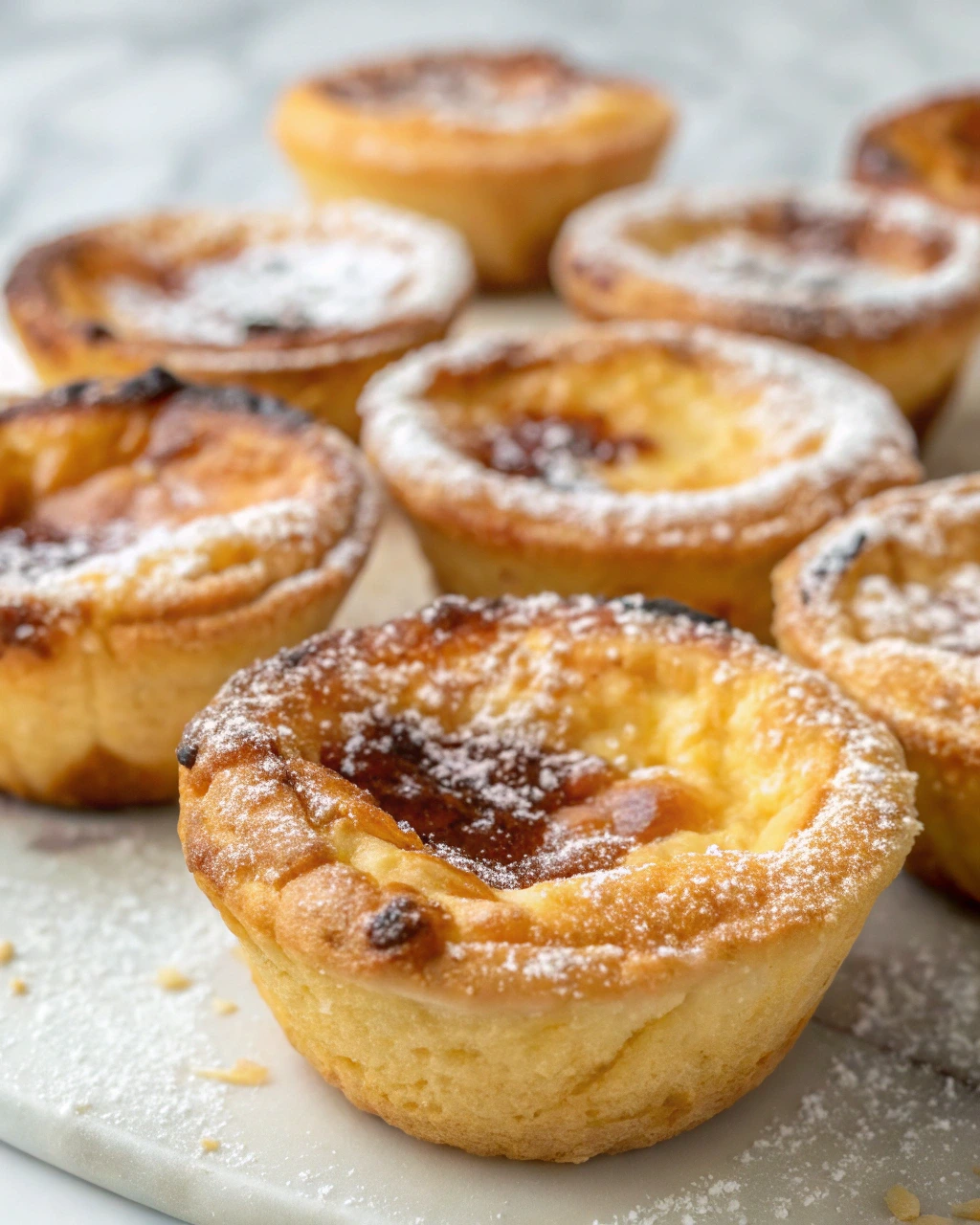Craving a warm, flaky pastry but avoiding gluten? You’re not alone. With food allergies, sensitivities, and health-conscious lifestyles on the rise, gluten free pastries are no longer a niche indulgence — they’re a must-have in bakeries and kitchens worldwide. This guide unpacks everything from the basics of gluten-free baking to where you can snag the best gluten free desserts and how to make your own at home. Whether you’re celiac, gluten-sensitive, or just curious, we’ve got your sweet tooth covered — without the wheat!
Table of Contents
What Are Gluten Free Pastries?
Understanding Gluten and Gluten Intolerance
Gluten is a protein found in wheat, barley, and rye. It gives dough that stretchy, chewy feel we all know and love. But for millions of people, gluten is a real troublemaker. Folks with celiac disease or gluten sensitivity can’t digest it properly, which can lead to all sorts of nasty health problems — from bloating and fatigue to more serious autoimmune issues.
So, what’s the fix? Enter the world of gluten free pastries — heavenly baked goods made without traditional wheat-based flours. These treats ditch the gluten but keep all the flavor and texture. Sound too good to be true? It’s not — trust us!
What Makes a Pastry Gluten-Free?
A pastry earns its gluten-free badge by skipping ingredients that contain wheat, barley, or rye. Instead, it uses alternatives like almond flour, coconut flour, or rice flour. But it’s not just about switching the flour. Bakers also need to be careful with equipment and surfaces to avoid cross-contamination — especially if the goodies are meant to be safe for celiacs.
To ensure safety and quality, many specialty bakeries label their products as certified gluten-free. That means extra steps were taken to eliminate even trace amounts of gluten. Handy, right?
Why Choose Gluten Free Pastries?
Even if you’re not medically required to go gluten-free, there are tons of reasons to try. Some people find they feel less bloated and more energized after ditching gluten. Others just love exploring new flavors — like the nutty depth of almond flour or the tropical twist of coconut. Plus, wheat-free pastries can be part of other special diets, including keto, paleo, or even dairy-free lifestyles.
Whether you’re looking for a better-for-you indulgence or just want to try something new, gluten free pastries offer a whole new way to treat yourself without compromise.
Common Ingredients in Gluten Free Pastries
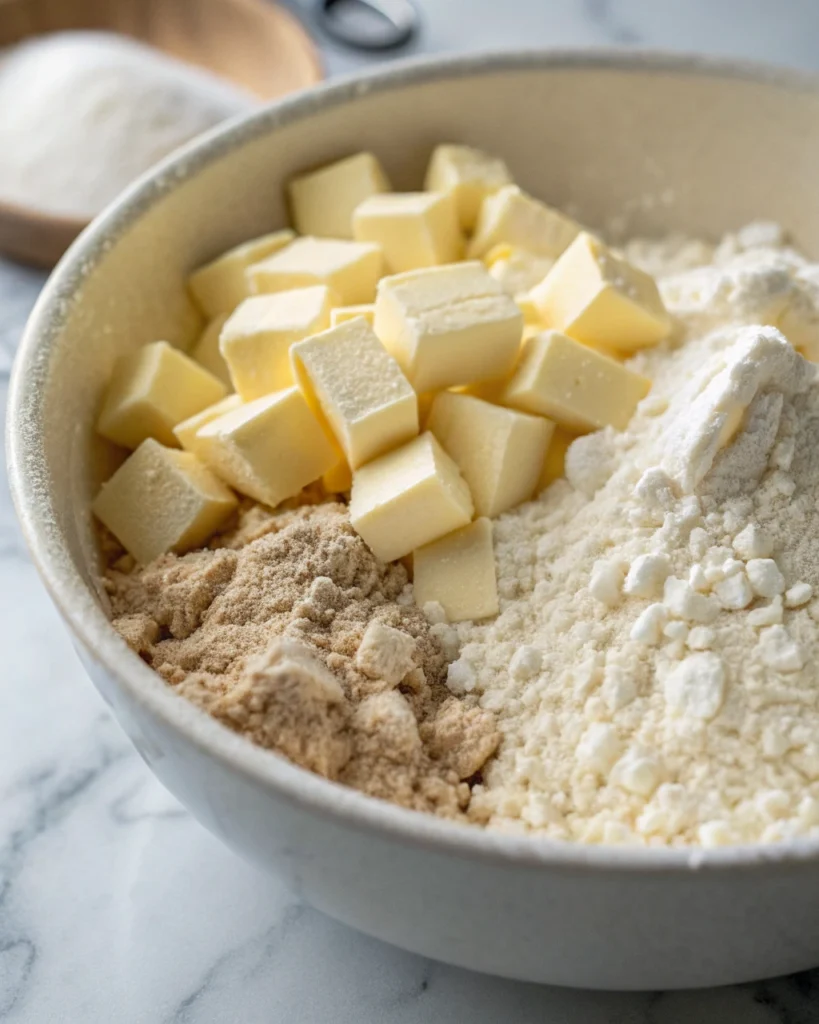
Naturally Gluten-Free Flours: Almond, Rice, and Coconut
When it comes to making gluten free pastries that taste just as good as the classics, flour swaps are your best friends. Almond flour, with its rich, nutty flavor, adds a moist, tender crumb. Rice flour offers a neutral base perfect for delicate bakes, while coconut flour brings sweetness and absorbs moisture like a sponge. Each one brings a little something different to the table.
But wait — it’s not just about taste. These flours are also packed with nutrients and are naturally gluten-free. Want to skip the measuring math? Try premade blends like King Arthur’s Measure for Measure, which takes out the guesswork. Just remember, not all flours are created equal, so mixing them often yields the best results.
Binders and Thickeners: Xanthan Gum, Psyllium Husk
Here’s the deal — gluten is what gives dough its elasticity. Without it, your pastry might crumble like a sandcastle. That’s why gluten free baking needs a little extra help. Enter binders like xanthan gum and psyllium husk. These clever ingredients mimic gluten’s structure, keeping everything nice and chewy, not dry and dusty.
You’ll find xanthan gum in many commercial gluten-free flour mixes. It helps dough stretch and rise, acting like a culinary glue. Psyllium husk, on the other hand, is your go-to if you’re aiming for a more whole-grain, fiber-rich bake. Don’t skip these — they’re game-changers for making gluten free pastries that hold together beautifully.
Sweeteners, Spices, and Dairy Alternatives
From maple syrup to coconut sugar, alternative sweeteners are key in gluten-free pastry kitchens. They not only add depth of flavor but also pair well with nut-based and grain-free flours. When it comes to spices, think cinnamon, nutmeg, and cardamom — all naturally gluten-free but watch out for blends that might include sneaky flour fillers.
And let’s not forget the dairy! Plenty of folks going gluten-free also opt for dairy-free pastries. Coconut milk, oat milk (certified gluten-free, of course), and plant-based butters keep things creamy without compromising dietary needs. Always check labels, though — even your favorite chocolate chips might carry traces of gluten.
Types of Gluten Free Pastries You Can Enjoy
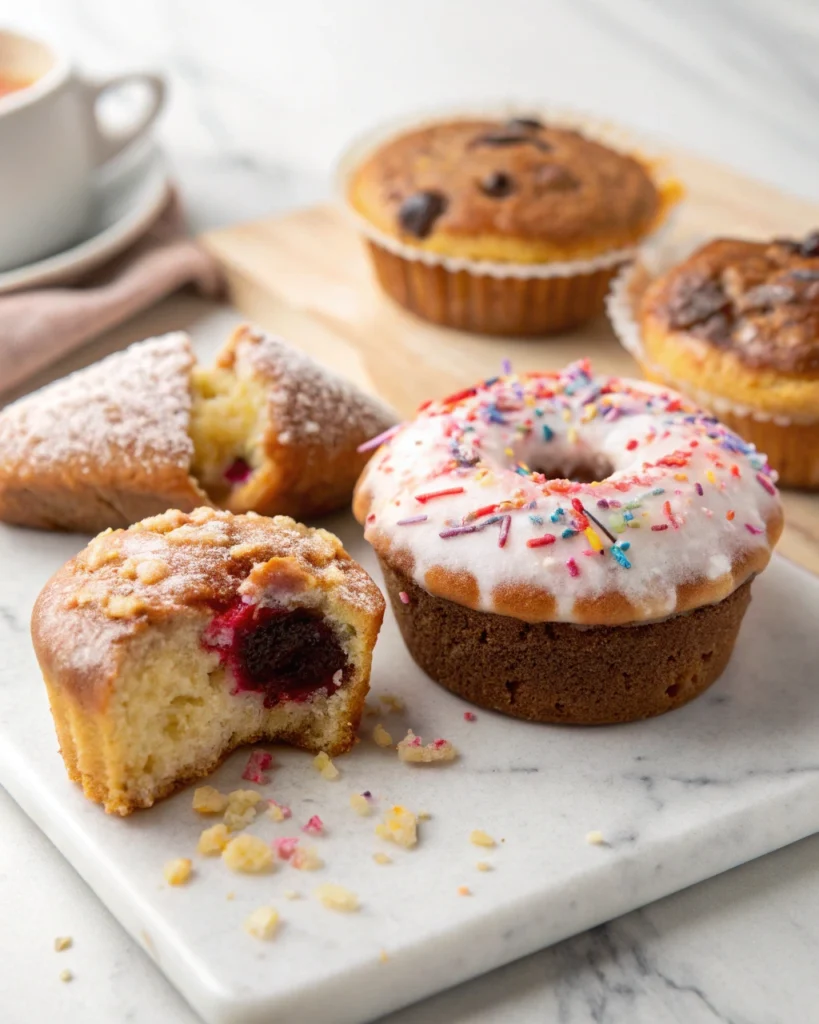
Gluten Free Muffins, Cupcakes, and Donuts
Craving a muffin with your morning coffee or a sweet cupcake after dinner? No problem. Gluten free pastries come in all shapes and sizes, and muffins and cupcakes are among the most popular. From blueberry almond to chocolate chip banana, the flavor combos are endless.
And let’s talk donuts — yes, really! Thanks to dedicated donut shops and gluten-free mixes, fluffy, golden rings of joy are just a few steps away. Whether baked or fried in a dedicated gluten-free fryer, they’re a sweet treat without the worry.
Tarts, Scones, and Cinnamon Rolls
Looking for something a bit more refined or cozy? Gluten-free fruit tarts made with almond flour crusts are a hit at parties, and they’re surprisingly easy to make. Prefer a rustic vibe? Scones made with sorghum or oat flour offer the perfect balance of crumbly and rich — just the thing with a cup of tea.
Now, about those cinnamon rolls. The classic morning indulgence is totally doable sans gluten. Thanks to fluffy blends and yeast tricks, these gooey spirals are as good as the real deal. Trust us — your kitchen will smell like a bakery.
Seasonal and Cultural Variations (e.g., GF Baklava, GF Empanadas)
Pastries don’t have to be basic. Across the globe, recipes are being reimagined to fit gluten-free lifestyles. Love Mediterranean flavors? Try gluten-free baklava with layers of almond flour phyllo and maple syrup. Craving savory? Empanadas made with cassava or corn-based doughs are flaky, hearty, and naturally gluten-free.
Exploring gluten free pastries from different cultures is a great way to keep things fresh. Just make sure to check ingredient labels or stick to certified recipes, especially when making treats for those with celiac disease.
Where to Buy the Best Gluten Free Pastries
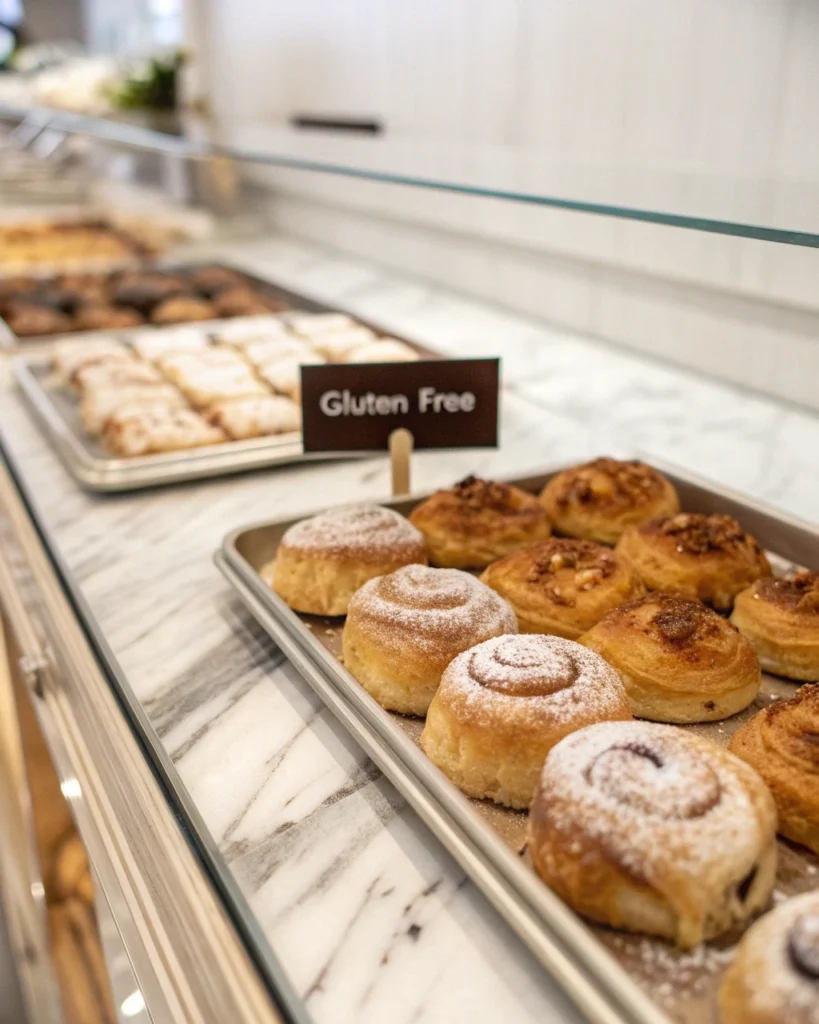
Top Gluten-Free Bakeries in the U.S.
Finding top-notch gluten free pastries can feel like a wild goose chase — unless you know where to look. Across the U.S., dedicated gluten-free bakeries are rising in popularity, offering everything from croissants to eclairs that are 100% safe and swoon-worthy. Spots like Erin McKenna’s Bakery in New York and Wildflour in California are changing the pastry game for people with celiac disease and gluten intolerance alike.
These bakeries often go the extra mile by sourcing certified gluten-free ingredients and baking in dedicated facilities to prevent cross-contact. So, if you’ve ever dreamed of a gluten-free éclair or pain au chocolat, these are the places to check out.
Spotlight: Spokane’s Best Gluten-Free Pastry Spots
In Spokane, Washington, a surprising number of bakeries have embraced gluten-free baking. For instance, Cole’s Bakery & Café offers a fully gluten-free menu that includes muffins, donuts, and even layered cakes. Boots Bakery & Lounge is another gem — 90% of their offerings are gluten-free, and the vibe is just as sweet as the pastries.
These local spots not only serve up flavor, but also peace of mind. Thanks to dedicated prep areas and trained staff, cross-contamination risks are kept low, making these locations ideal for anyone seeking safe and scrumptious gluten free desserts.
Online Stores and Delivery Options
Can’t find a gluten-free bakery nearby? No worries. You can order top-quality gluten free pastries online and have them delivered to your doorstep. Sites like Katz Gluten Free, Savor by Suzie, and Modern Bread & Bagel offer everything from cinnamon rolls to soft pretzels.
And get this — many of these bakeries ship nationwide, and some even offer subscription boxes! It’s like a monthly care package from your favorite baker, minus the gluten and hassle.
For more delicious ideas and home-baked inspiration, check out our detailed recipe article on how to make gluten-free puff pastry at Sweet Treats Recipes.
How to Make Gluten Free Pastries at Home
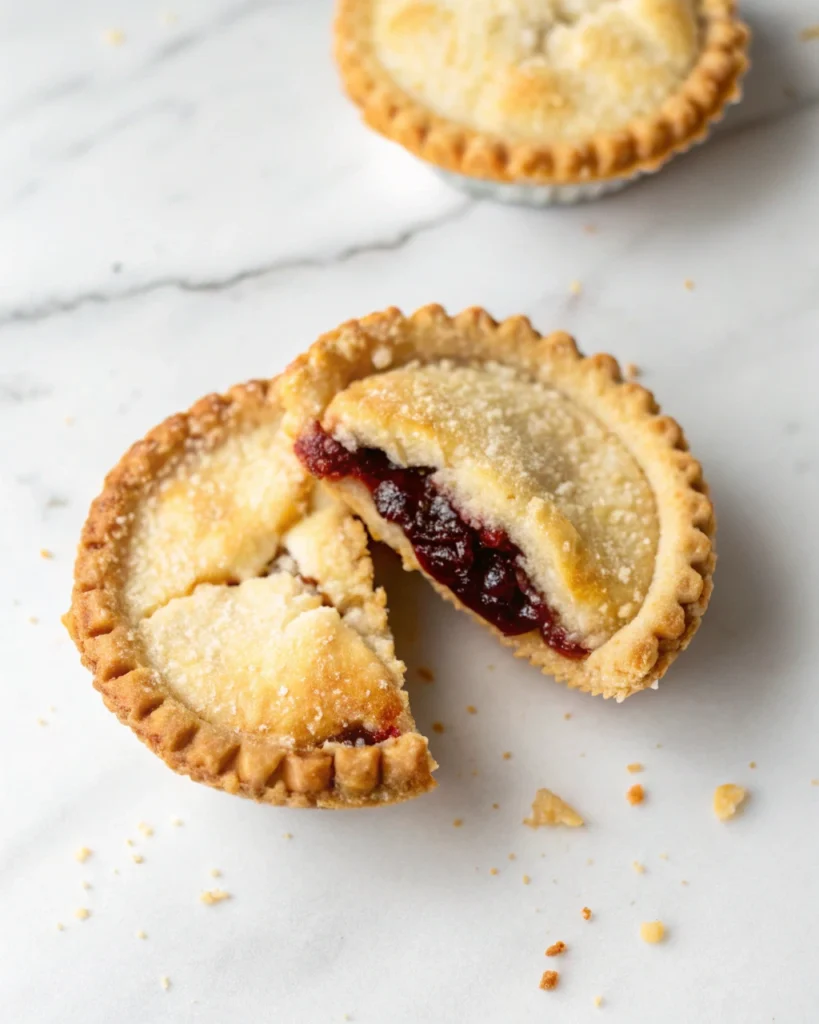
Basic Gluten Free Pastry Dough Recipe
Think homemade pastry dough is too tricky without gluten? Think again. With the right mix of flours and a few tips up your sleeve, it’s easier than you might think. A basic gluten-free pastry dough starts with a blend of almond flour, rice flour, and a starch like tapioca or potato. Add cold butter or a dairy-free substitute, a pinch of salt, and a touch of water — and voilà, your dough is ready to chill.
Don’t forget a binder like xanthan gum to help hold everything together. It adds elasticity and mimics that stretchiness you’d get from wheat flour. Roll it out between parchment sheets to avoid sticking and you’re set for pies, tarts, or even savory hand pies.
Tips for Baking with Gluten-Free Ingredients
Gluten-free flours behave differently, so it helps to know a few tricks. First off, always weigh your ingredients — it’s more accurate than using cups. Also, let your batter rest for 15–30 minutes before baking to hydrate the flours and improve texture. A little patience goes a long way!
Consider using an oven thermometer too. Gluten-free pastries are often more sensitive to temperature changes, so keeping things steady helps a ton. And lastly, don’t skip the sifting — it aerates your flour and keeps the texture light and flaky.
Avoiding Cross-Contamination in Your Kitchen
This part’s crucial if you or your guests are gluten-sensitive. Clean all surfaces, tools, and pans thoroughly. Better yet, dedicate certain utensils or even mixers for gluten-free use only. Store gluten-free ingredients in sealed containers, and always read labels — even something simple like baking powder can sneak in unwanted gluten.
Going the extra mile ensures your kitchen remains a safe space for whipping up the most delightful gluten free pastries, free from any trace of gluten. After all, nothing ruins a great bake like a contaminated batch.
Are Gluten Free Pastries Healthier?

Nutritional Comparison with Traditional Pastries
Let’s clear the air — just because something is gluten-free doesn’t automatically make it healthier. That said, many gluten free pastries do offer some unique perks. For starters, they often use flours like almond, buckwheat, or coconut, which are higher in fiber and protein compared to regular white flour.
These alternative flours can also pack in more vitamins and minerals. Plus, gluten-free options tend to skip the processed fillers you’ll find in mass-produced treats. Still, it’s smart to check labels — sugar and fat can still be high, just like in any pastry. So, while gluten free desserts can be more nutritious, they aren’t necessarily guilt-free. Moderation is still key.
Portion Control and Sugar Content
It’s easy to think you can eat more of something just because it’s gluten-free. But here’s the thing — sugar is sugar, no matter the flour. Some gluten free pastries might even have extra sugar to balance out the texture or flavor. So always take a peek at the ingredients list.
On the bright side, many home-baked or specialty gluten-free treats let you tweak the sweetness. That means you can use natural sweeteners like honey or maple syrup. Even better, smaller batch baking encourages portion control. So yes, you can enjoy your pastry — just maybe not the whole tray in one go.
FAQs
What pastries are gluten-free?
Great question! Many classic pastries now come in gluten-free versions — think muffins, donuts, tarts, and cookies. If they’re made with gluten-free flours like almond or coconut and no wheat-based ingredients, they qualify. Be sure they’re baked in a gluten-safe environment if you’re sensitive.
What sweets are gluten-free?
Lots! From macarons (which are naturally gluten-free) to chocolate truffles and flourless cakes, sweet lovers have options. Many candies and even ice creams also fall into the gluten-free category — just double-check labels to avoid hidden wheat or barley.
What popular treats are gluten-free?
Brownies, banana bread, and cupcakes all have gluten-free alternatives. Even cinnamon rolls and croissants can be made without gluten nowadays. As long as the recipe ditches wheat and sticks to safe prep methods, you’re good to go!
Does gluten free pastry exist?
Absolutely. In fact, u003cemu003egluten free pastriesu003c/emu003e are becoming more mainstream every year. With high-quality flour blends and better baking knowledge, they can taste just as rich and flaky as traditional ones. You’ll find them at local bakeries, online stores, and even in the frozen aisle.
Are sweet tarts gluten-free?
It depends. Traditional sweet tarts use wheat-based crusts, but gluten-free versions are everywhere now. Look for ones made with almond flour, oat flour, or rice flour bases. Or make your own using a gluten-free crust recipe!
What is a good gluten-free snack to bring to a party?
Mini u003cemu003egluten free pastriesu003c/emu003e like lemon bars, brownie bites, or mini muffins are always crowd-pleasers. They’re easy to transport and perfect for sharing. Fruit tarts with a gluten-free crust also make a show-stopping centerpiece. Just label them clearly in case guests have allergies.
Conclusion
Summing Up the Gluten-Free Pastry Experience
So, what’s the takeaway? Gluten free pastries have come a long way — they’re no longer bland or boring. With the right ingredients and a little know-how, they can be just as tasty, flaky, and comforting as traditional ones. Whether you’re buying from a dedicated bakery or baking at home, there’s a whole world of delicious options waiting for you.
Thanks to better ingredients and more awareness, going gluten-free doesn’t mean giving up your favorite treats. In fact, it’s an invitation to explore new textures and flavors, often with fewer allergens and more mindful choices baked in.
Final Tips for Enjoying Gluten Free Pastries Safely and Deliciously
Here’s the deal — always check labels, especially for hidden gluten or cross-contact risks. When in doubt, go with certified gluten-free products or bake it yourself to be sure. It’s also smart to share what you’ve learned. Hosting a party or baking for others? Label your goodies clearly to help everyone enjoy with confidence.
And don’t be afraid to experiment. Try new flours, play with spices, and get creative with fillings. The world of gluten free pastries is full of surprises, and with every batch, you’re getting better at mastering it. Who says safe can’t be scrumptious?
Did you make this recipe?
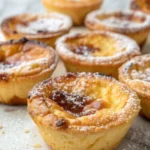
Basic Gluten Free Pastry Dough
- Total Time: 30 minutes
- Yield: 1 pie crust (serves 8) 1x
- Diet: Gluten-Free
Description
A simple and versatile gluten-free pastry dough perfect for tarts, pies, and more.
Ingredients
- 1 cup almond flour
- 1 cup rice flour
- 1/2 cup tapioca starch (or potato starch)
- 1/2 cup cold butter (or dairy-free substitute)
- 1/2 teaspoon salt
- 1–2 tablespoons cold water
- 1 teaspoon xanthan gum
Instructions
- In a mixing bowl, combine almond flour, rice flour, tapioca starch, xanthan gum, and salt.
- Add cold butter and mix until the mixture resembles coarse crumbs.
- Gradually add cold water, one tablespoon at a time, mixing until the dough comes together.
- Wrap the dough in plastic wrap and chill for at least 30 minutes.
- Roll out the dough between parchment paper to avoid sticking, then use it for your desired pastry.
Notes
For best results, let the batter rest for 15-30 minutes before baking. Always check for gluten-free labels on all ingredients.
- Prep Time: 10 minutes
- Cook Time: 20 minutes
- Category: Dessert
- Method: Baking
- Cuisine: Gluten-Free
Nutrition
- Serving Size: 1 slice
- Calories: 280
- Sugar: 1g
- Sodium: 200mg
- Fat: 20g
- Saturated Fat: 8g
- Unsaturated Fat: 10g
- Trans Fat: 0g
- Carbohydrates: 24g
- Fiber: 3g
- Protein: 6g
- Cholesterol: 30mg
Keywords: gluten-free pastry, pastry dough, almond flour, rice flour, baking, dessert recipe

